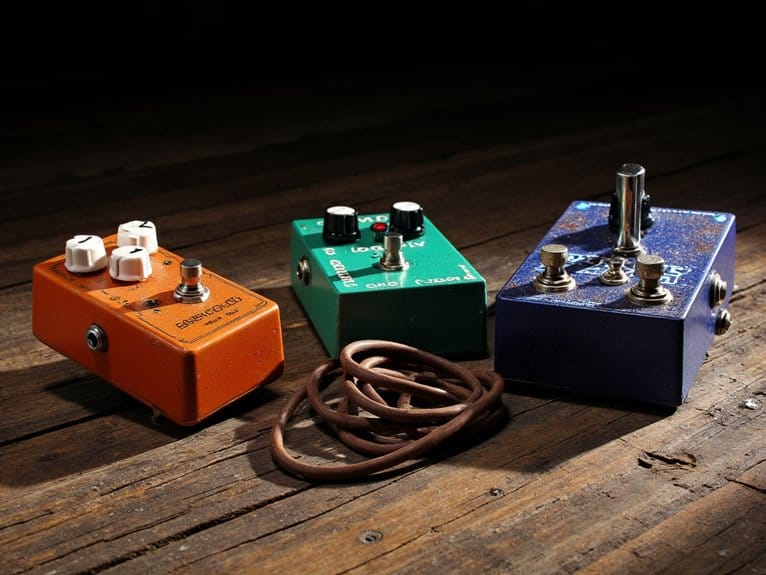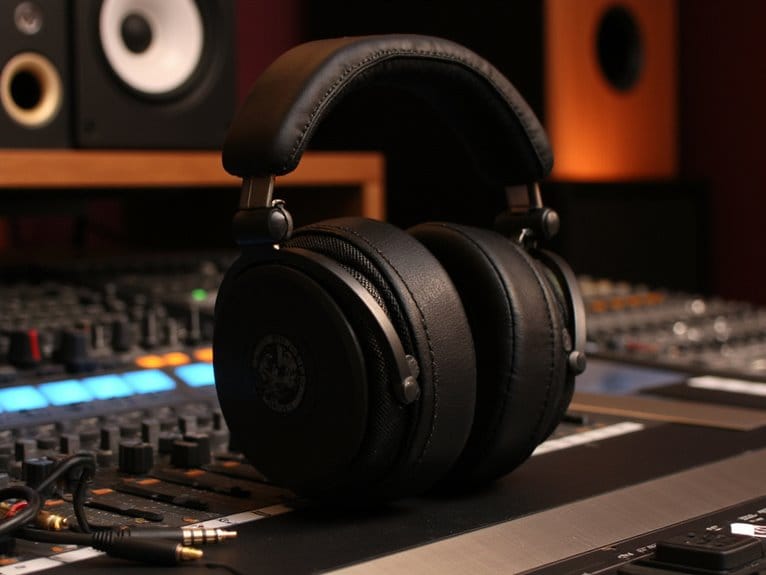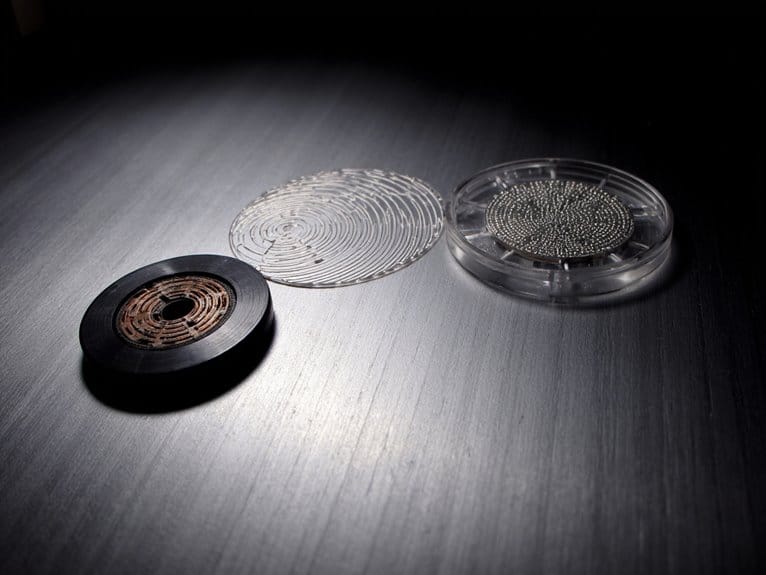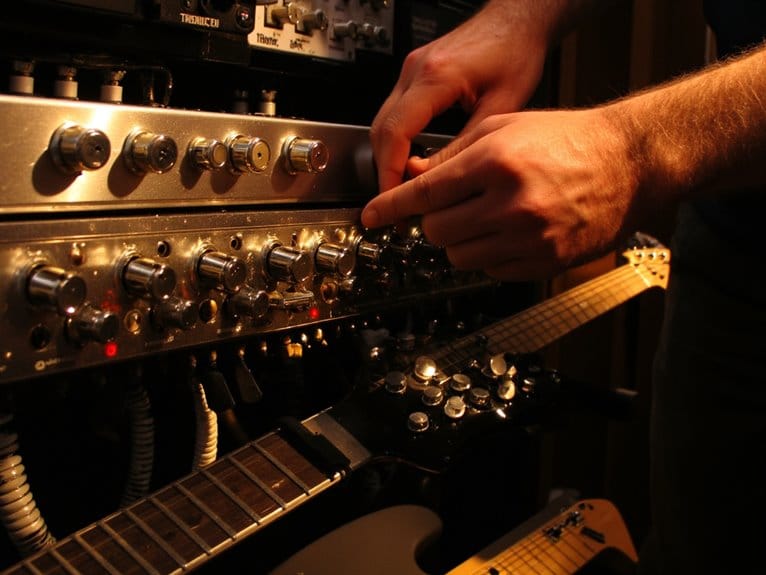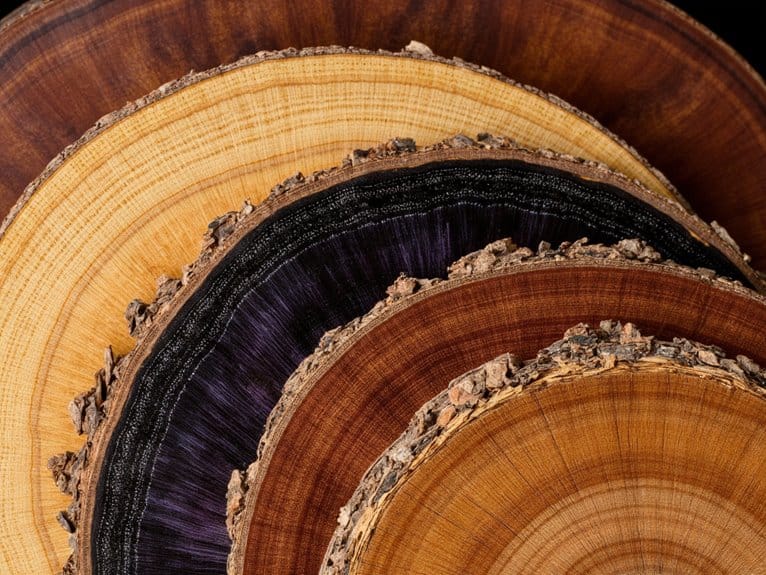Guitar Effects for Different Music Genres
Your guitar effects choices fundamentally shape your genre’s signature sound, whether you’re crafting blues warmth with tube-style overdrive and subtle reverb, rock power through midrange-focused distortion pedals, punk aggression using high-gain units like the Boss DS-1, jazz sophistication with clean compression and chorus, metal intensity via noise gates and boost pedals, or indie atmosphere through delay and ambient reverb combinations that create distinctive textural landscapes for each style’s authentic expression.
We are supported by our audience. When you purchase through links on our site, we may earn an affiliate commission, at no extra cost for you. Learn more.
Notable Insights
- Blues requires clean boost, medium-gain overdrive like Tube Screamer, and reverb for authentic warm tone with natural saturation.
- Rock emphasizes midrange frequencies (1-4 kHz) using overdrive/distortion pedals with independent EQ controls for clarity against rhythm section.
- Punk utilizes moderate distortion like BOSS DS-1 with compression and flanger effects for tight rhythms and raw energy.
- Metal demands high-gain pedals, noise gates for signal management, and boost pedals for increased saturation during solos.
- Jazz focuses on subtle compression, warm reverb, chorus, and low-level delay to complement hollow-body guitars’ natural warmth.
Blues Guitar Effects and Tone Shaping
When I first started exploring blues guitar, I quickly discovered that achieving authentic blues tone isn’t just about cranking up the volume—it’s about understanding how different gain stages work together to create that sweet, saturated sound that makes every note sing with emotional weight.
Essential blues pedals include clean boost pedals for pushing tube amps into natural overdrive, medium-gain overdrive pedals like the Tube Screamer for characteristic grit, and reverb for spatial warmth.
These effects enhance tone dynamics without overwhelming your signal, allowing expressive phrasing that breathes with each note.
I’ve learned that ‘always on’ boost pedals create a thick base tone, compensating for the thinness of straight guitar-to-amp signals while maintaining signal integrity and consistency across different pickups. The beauty of blues tone lies in keeping your effects simple rather than layering complex combinations that can muddy the raw, gritty character that defines the genre. Many blues guitarists prefer fewer effects overall, focusing instead on perfecting their core sound and letting their technique drive the expression.
Overdrive pedals with true bypass designs are particularly valuable for blues players as they maintain signal clarity when the pedal is disengaged, preserving the natural tone of your guitar and amp. Budget-friendly options like the JOYO Vintage Overdrive deliver classic tube warmth overtones at lower volumes while providing gain saturation that’s perfect for blues applications. Comprehensive EQ controls help fine-tune your distortion sound to match the specific tonal requirements of different blues styles, from Chicago blues to modern blues rock.
Rock Guitar Effects for Power and Presence
When you’re crafting that signature rock sound, you’ll find that essential overdrive and distortion pedals serve as the foundation for achieving the aggressive, saturated tones that define the genre’s power and presence.
Your Marshall amp settings become vital in this equation, as they provide the tube-driven breakup and natural compression that transforms clean signals into the gritty, harmonically rich textures that cut through dense rock mixes with authority.
The secret lies in emphasizing midrange frequencies, which I’ve learned through years of tone chasing, because these frequencies carry the punch and clarity needed to make your guitar parts stand out against heavy drums and bass without getting lost in the sonic chaos. Independent treble, mid, and bass knobs on your distortion pedal allow for precise EQ shaping to dial in exactly the tonal clarity you need for your rock sound. Modern multi-effects pedals can provide over 360 effects and 120 amplifier models, giving rock guitarists unprecedented versatility in crafting their signature sound. The classic Boss DS-1 has delivered this essential rock crunch since 1978, making it the second best-selling distortion pedal for good reason. Distortion pedals produce harmonic overtones that create the grainy, saturated sound that has been the backbone of rock music since the 60s.
Essential Overdrive and Distortion
Although I’ve tested dozens of overdrive and distortion pedals over the years, I’ll admit that understanding the fundamental differences between these two effect types can initially seem confusing, especially since both add gain and saturation to your guitar signal.
The overdrive characteristics center around natural tube amp simulation, preserving your guitar’s original tone while adding warmth and sustain that responds dynamically to your playing intensity. Distortion nuances involve higher gain compression, creating heavier, more consistent saturation regardless of pick attack.
| Aspect | Overdrive | Distortion |
|---|---|---|
| Gain Level | Mild to moderate | High compression |
| Tone Response | Dynamic, natural | Consistent, saturated |
| Best Use | Blues, classic rock | Hard rock, metal |
You’ll find overdrive pedals like the Tube Screamer excel at boosting amp gain naturally, while distortion pedals provide aggressive saturation for heavier styles. The signature midrange boost of these pedals ensures your guitar cuts through the mix effectively during solos and rhythm playing. High-gain distortion pedals transform any amplifier into a powerhouse of analog aggression, delivering thick, saturated tones while preserving clarity across genres, making them essential for achieving everything from AC/DC crunch to Metallica’s heavy metal sound. When selecting an overdrive pedal, true bypass circuitry is crucial as it preserves your guitar’s natural signal integrity when the effect is disengaged.
Marshall Amp Settings
Since I’ve spent countless hours dialing in Marshall amps across various venues and recording sessions, I can tell you that achieving that signature rock power and presence isn’t just about cranking the volume—it’s about understanding how each control interacts to shape your tone’s fundamental character.
Start with Marshall overdrive channel selection, avoiding the clean channel completely for authentic rock tones. Gain optimization begins around 3-5 for classic crunch, while 6-10 delivers modern saturation. Set treble high at 5-8 for cut, bass moderately at 5-7 for fullness without muddiness, and presence around 3-6 for attack definition.
While Marshall tube amps remain the gold standard, modern solid-state amps can deliver impressive rock tones with dual-channel designs and built-in effects that rival traditional setups. Pair with a 4×12 closed-back cabinet loaded with Celestion speakers, keep reverb minimal, and drive those power tubes hard for natural compression.
Midrange Frequency Emphasis
The secret weapon that transforms thin, wimpy guitar tones into commanding rock powerhouses lies in understanding how midrange frequencies shape your sound’s fundamental character and cutting power.
Through effective midrange shaping techniques, you’ll discover that boosting frequencies between 1-4 kHz delivers the articulation and presence that separates amateur recordings from professional productions.
I’ve found that setting your amp’s mids to 6-8 while reducing bass and treble to 3-5 creates that classic rock crunch, though you’ll want to cut around 400 Hz to eliminate muddiness.
Smart frequency balance strategies involve targeting 2.5-4 kHz for aggressive bite while maintaining moderate low-end support, ensuring your guitar cuts through dense mixes without competing with vocals or creating listener fatigue.
Essential overdrive pedals with simple gain and tone controls provide the foundation for achieving these midrange-focused rock tones without overwhelming beginners with complex parameter adjustments.
A volume pedal positioned after your overdrive tones allows for seamless swells and dynamic control that enhances the midrange emphasis without sacrificing your carefully crafted frequency balance.
Punk Guitar Effects: Raw and Aggressive Sounds
When you’re building a punk guitar rig, your pedal selection and amplifier configuration become critical foundations for achieving that characteristic raw, aggressive sound that defines the genre.
I’ve found that most effective punk setups rely on just 2-3 essential pedals—typically a distortion like the BOSS DS-1, a modulation effect such as chorus or phaser, and a reliable tuner—paired with moderate amp gain settings that let your pedals shape the tonal character without creating muddy overdrive.
Your amplifier choice matters considerably here, as Fender-style amps and Marshall Plexis provide the crunchy yet clear overdrive foundation that works exceptionally well with single-coil guitars and distortion pedals in punk applications.
Adding a compression pedal with true bypass circuitry can help maintain signal integrity while providing the sustain and clarity needed for tight, aggressive punk rhythms without compromising your raw tone.
For additional sonic texture, incorporating a flanger pedal can introduce that classic jet-plane effect that adds rhythmic complexity and emphasizes the aggressive character essential to punk’s raw energy.
Essential Punk Pedals
Although punk guitar tones might seem straightforward on the surface, achieving that perfect balance of raw aggression and cutting clarity requires more finesse than you’d expect from a genre built on three-chord simplicity.
The Ibanez Tube Screamer remains your go-to overdrive for pushing tube amps into vintage punk territory, while Boss’s DS-1 delivers that cutting edge rawness.
For dedicated pedal customization, Tone For Punk’s Distort47 offers germanium diode and MOSFET clipping options, giving you serious sonic experimentation potential.
Classic fuzz pedals like the Fuzz Face provide thick, mid-focused grit that cuts through aggressive rhythm sections.
Amplifier Setup Tips
Once you’ve dialed in your pedal chain, your amplifier becomes the foundation that’ll make or break your punk tone—and honestly, I’ve seen more guitarists sabotage great riffs with poor amp settings than I care to count.
For amp selection, I recommend starting with heads like Orange Rockerverb or Peavey 6505 MH, which offer distinct gain stages that respond beautifully to aggressive playing dynamics. Your gain management should focus on finding that sweet spot where you get crunchy overdrive without sacrificing chord clarity—usually around 6 or 7 rather than maxing everything out.
Cabinet choice acts as your tone’s final equalizer, with open-back designs delivering the raw, natural sound that punk demands while maintaining the midrange cut you need. If you prefer the convenience of a combo setup, consider models like the Marshall DSL40CR with its tube-driven circuits that deliver the rich dynamic sound essential for authentic punk aggression.
Jazz Guitar Effects: Clean and Warm Tones
While rock guitarists chase screaming distortion and metal players hunt crushing gain, I’ve found that jazz musicians pursue something far more elusive: the perfect clean, warm tone that lets every nuance of their playing shine through without electronic interference.
Jazz pedalboards typically feature reverb pedals like the Electro-Harmonix Holy Grail Plus for spatial depth, subtle compression to smooth dynamics, and carefully-dialed EQ to enhance warmth without sacrificing clarity.
Warm guitar techniques emphasize restraint—using chorus sparingly for thickness, delay with low mix levels for ambiance, and occasional overdrive for harmonic texture rather than saturation.
The Strymon Flint’s vintage tremolo and reverb perfectly complement hollow-body guitars through tube amplifiers, while the Xotic RC Booster provides transparent gain for solos without compromising your instrument’s natural character. Many affordable instruments feature rosewood fingerboards that enhance tone quality while maintaining the warm characteristics essential to jazz performance.
For jazz bassists seeking similar tonal warmth, instruments like the Yamaha TRBX174 with its mahogany construction naturally provide the warm tones that complement traditional jazz guitar setups.
Metal Guitar Effects: High-Gain Saturation and Control
While jazz guitarists obsess over pristine clean tones, metal players dive headfirst into the beautiful chaos of high-gain saturation, building pedalboards that can release devastating sonic assault while maintaining surgical control over feedback and unwanted noise.
Your high gain pedals become the foundation, with options like the Electro Harmonix Metal Muff delivering thick, saturated aggression, while the Revv Northern Mauler combines dual circuits for versatile chainsaw tones.
Understanding distortion characteristics matters—hard clipping provides tight crunch, soft clipping offers smoother saturation control.
Professional guitarists often rely on 3-band EQ systems to shape their high-gain tones with precision, allowing precise frequency adjustments that complement aggressive playing styles.
Noise management becomes critical through pedals like MXR Smart Gate, which eliminates hiss during fast rhythm sections.
EQ shaping with graphic equalizers lets you scoop mids for modern chug or boost them for cutting leads.
For solo sections, boost pedals like the Xotic EP Booster Mini can push your amp into deeper saturation while providing the essential +12dB to +20dB gain range that cuts through dense rhythm layers.
Alternative and Indie Guitar Effects: Textured Soundscapes
Alternative and indie guitarists craft their signature sounds through carefully selected effects that prioritize texture and atmosphere over sheer power. They build pedalboards that transform simple chord progressions into rich, layered soundscapes that define the genre’s aesthetic.
Your essential toolkit includes overdrive pedals for warm tube saturation, delay effects for rhythmic echoes, and reverb for cavernous ambience. Fuzz pedals add raw grittiness, while compressors smooth dynamics for consistent thickness. Chorus pedals create depth and richness that work exceptionally well across various musical genres, adding the textured layers that define indie guitar tones.
Sound layering techniques involve combining overdrive with compression, then adding delay and reverb for atmospheric dynamics.
Popular choices include the Wampler Plexi Drive, favored by J Mascis, and EQD’s Dispatch Master for spatial effects. Minimalist setups typically feature tuner, overdrive, delay, reverb, and compressor, though multi-function pedals like Valeton’s Dapper Indie offer extensive indie textures in compact formats.
Frequently Asked Questions
What’s the Optimal Pedal Chain Order for Multi-Genre Guitarists?
You’ll want tuner first, then compression, followed by gain pedals from lightest to heaviest distortion. Place modulation and time-based effects last for ideal pedal combinations and versatile tone shaping across genres.
Should I Buy Separate Amplifiers for Each Musical Genre I Play?
You don’t need separate amplifiers for each genre. Modern amps offer excellent amplifier versatility through EQ settings, gain controls, and built-in effects. Focus on genre compatibility by choosing one flexible amp that handles multiple styles effectively.
On a final note
You’ve now got the essential effects knowledge for each major genre, from blues overdrive’s warm saturation to metal’s high-gain distortion and compression chains. Remember, these aren’t rigid rules—I’ve seen jazz players use fuzz pedals and metal guitarists embrace clean tones effectively. Start with your genre’s foundational effects, then experiment boldly. Your personal sound develops through understanding these conventions, then breaking them creatively when musical expression demands it.

